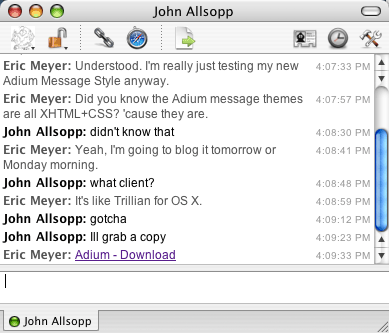S5 1.2a1
Published 19 years, 11 months pastIt’s back: S5 1.2 alpha 1 is now available (177 KB Zip archive), and you can play with either the OSF or XOXO versions of the latest development version if you just want to preview it online. In addition, I’ve set up a contact address specifically for S5 questions and feedback. You can find a link to this new address on the main S5 page.
New to S5 1.2:
-
The progress indicator (e.g., 6/10) is now a permalink to the currently-displayed slide. This will require an update to any S5 1.1-era themes, but it’s a minimal thing. Granted, the current alpha doesn’t have updated styles to handle the presence of a link. I’ll get to it.
-
Bug fixes intended to make it more Konqueror-friendly. I do not know if Konqueror will run S5 1.2. I do not have access to Konqueror. The fixes I included were sent to me by helpful S5 users, and may or may not have resolved all problems. If there are still bugs in S5 when displayed in Konqueror, you are invited to submit bug fixes in the comments, or via the contact address I mentioned before. Bug reports should be done in the comments, where other Konqueror users can see them, and not via the contact address.
-
Vastly improved integration with Opera. As chronicled in “Opera and S5 1.1“, S5 was originally intended to be a cross-browser emulation of OperaShow. As time went on and features were added, the two diverged. Thanks to efforts by Hallvord Steen, Opera should now be shut out of a lot less of S5 than it was. In fact, it may well be feature-complete as compared to S5 1.1, and will get most of S5 1.2’s features. With one possible exception…
-
A “notes” window capability. The notes view is largely the work of Shaun Inman, who wrote me last week to say, “Hey, I did this. Interested?” Was I ever! I’d been meaning to do it ever since I saw the notes view in Keynote, but Shaun got there first, clever wolf that he is.

To see this in action, in either the OSF or XOXO versions, hit “n”, or call up the controls and click on the three-line icon on the left. A new “notes” window will open, looking very much like the “notes” view in Keynote. This window displays whatever notes the author has created for the current and next slides; these are done by placing content in an element with a class of
notes, pretty much exactly like thehandoutfeature from earlier versions of S5. The notes window also includes timers showing the time elapsed since the presentation was opened and the time elapsed since the current slide was loaded. There’s also a pauseable countdown timer for those who prefer to keep track of time that way. (I added the countdown timer. Yay me!)The general idea is that you load up your presentation, open the notes window, and put the presentation up on the projector while keep the notes window on your presentation machine. (Which is of course only possible if you turn off video mirroring.) As you move through the slide show, you can see notes to yourself and keep track of time so you don’t run over. Keen. I don’t know how much I personally will use the notes, but I’m all over the timers like they were a stack of pancakes and I were Mrs. Butterworth.
At the moment, the JavaScript that opens the notes window is minimal, so the notes window is fairly chromeless and not resizeable in IE/Win. It’s also a bit rough in terms of some of its layout, as befits the alpha status. I’m also considering adding a keyboard command for “fullscreen”, which would maximize all open S5 windows to fill the screen they’re currently occupying, and possibly also strip away the browser chrome. I did a few experiments along those lines, but wasn’t satisfied with the results, so it didn’t get into this release.
On a related note, I’m not sure that notes can be made to use with Opera so long as S5 relies on OperaShow, because OperaShow by its very nature makes all browser windows fullscreen. If there’s a way to get OperaShow to put one window on one monitor, and a second on a second monitor, then that would be the answer. If not, I’m not sure what to do short of abandoning OperaShow usage entirely, which seems strange and wrong. But we’ll see. If nothing else, we can verify that everything in S5 besides the notes feature works in Opera, and push those changes into an S5 1.1.1 release.
One known problem is that when Firefox displays an S5 show using the text/xml or text/xhtml+xml MIME types, which is necessary for slide shows that incorporate things like MathML and SVG, things break because innerHTML ceases to be supported. I have a proposed fix submitted by an S5 user, but did not get it into 1.2a1. I plan to correct this before reaching the first beta release.
A number of people have asked for a merging of effects libraries like Script.aculo.us and FACE, and there have even been scattered implementations of same. It’s definitely tempting. I’m not at all confident that this will happen for 1.2, though, mostly because I don’t understand enough programming to make the connections. I’m also not sure how many of these I could pile into the code before the whole thing came crashing down. I have hopes that we’ll be able to work out a “best practices” way to add such capabilities to any S5 presentation file, and let each author add them or not as they see fit.
So there you go. Have at it!
